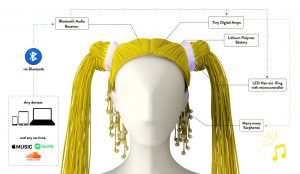AR Music Kit is an interactive audio device created by London-based sound artist/designer Yuri Suzuki. It was developed in partnership with his YS Labs team and Google’s Data Arts Team.
AR Music Kit creates a unique ‘do it yourself’ musical experience which allows users to make music using just an app, print outs and everyday objects. Users print and cut out black and white square markers and stick these onto any objects they wish to create music with. Using a smartphone camera and the free mobile app, users capture themselves interacting with their setup. The camera senses when they ‘play’ a note/chord (by covering a marker with their hands) and the phone produces the corresponding sound. 3 modes are currently available: piano, guitar and music box.
It’s a very democratic and accessible interactive device as users don’t have to physically obtain or purchase it in order to enjoy it. Instead, it makes use of augmented reality sensors, paper print outs and a smartphone which are (relatively) easily available. The experience is also entirely customisable and can appeal to people of varying ages and musical ability.
The app is free and the software is available online on github in order to encourage developers, students or hobbyists to improve and further develop the project.
Aside from the great augmented reality musical experience, I really appreciate the spirit of openness and democracy of this device. It is simple, inclusive and enabling.
http://www.yslab.co/work/ar-music-kit
Other works by Yuri Suzuki: http://yurisuzuki.com/







